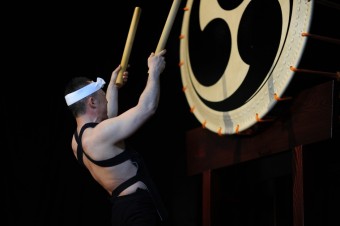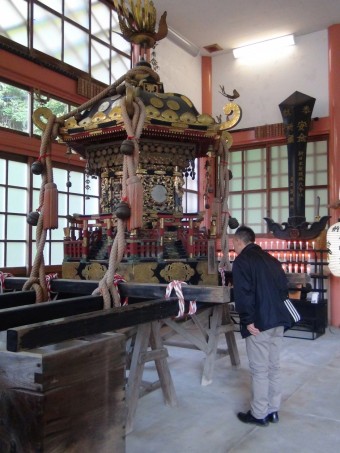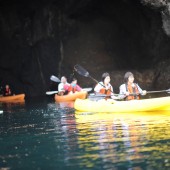Posts by Kodo Ensemble Leader
“Appearance at Opening Event for Joetsu Myoko Station” by Tomohiro Mitome
Appearance at Opening Event
for Joetsu Myoko Station on New Hokuriku Shinkansen Line
We were invited to perform at two opening events for Joetsu Myoko Station on New Hokuriku Shinkansen Line: a private celebration in Takada City on Mar. 14 and a public performance at Joetsu Myoko Station’s Kamakura Dome on Mar. 15.
At this brand new station, we were joined on stage by three brand new Kodo junior members! They must have felt the pressure of being assigned some of the main parts to perform, but I am sure that it was a memorable debut for them to perform for so many people.
In April, a new high-speed ferry called “Akane” will run between Naoetsu Port and Ogi Port on Sado. Access to southern Sado Island will become much easier and faster using the new bullet train line and fast car ferry. We hope you will come to see us for the “Kodo Special Performances on Sado Island” this spring, and “Earth Celebration” this summer.
“Some Lessons I Have Learned from North American Taiko Groups” by Tomohiro Mitome
Mar. 1, 2015
Hello, everyone! How are you all doing?
This is Tomohiro Mitome, leader of taiko performing arts ensemble Kodo.
March is here and it is getting warmer and more comfortable day by day. While we are happy that spring has arrived, some of us are unfortunately suffering from hayfever here at Kodo Village.
The “Kodo One Earth Tour 2015: Mystery” North America Tour started at the end of January and is now over halfway through its two-month-long journey. In North America, there are many people who have been very kind and helpful to us since the days of Kodo’s antecedent group, “Sado no Kuni Ondekoza,” in the 70’s. They are members of taiko groups in the USA and Canada.
I heard a lot of stories about North American taiko groups from senior Kodo members before I had even joined Kodo, many of which are featured in the Kodo 30th Anniversary Publication Inochi Moyashite, Tatakeyo – 30 Years of Kodo – (in Japanese). In this blog post, I am going to write about my own personal experiences. I was last on tour in North America about eight years ago. At that time, I recall that their style of taiko featured traditions that had been passed down for generations and in addition, a new “North American taiko style” was beginning to emerge.
In Kodo’s early years, our ensemble toured in North America every year and the local taiko groups at each performance destination helped us so much and welcomed Kodo with great warmth. Among those many groups, one in particular, San Jose Taiko in California, even let us use their rehearsal space to store our stage props and tour equipment.

Recently, both San Jose Taiko and Kodo have experienced a shift in generations, and now Kodo’s senior members don’t go abroad on tour very much. So, one year San Jose Taiko organized a time for us to sit down together in a circle and talk to each other (pictured above). They arranged this opportunity because they felt that it was necessary for us to reignite our communication and exchange, in order to understand more about each group’s history, about taiko, about the Japanese-American community in the U.S., and to discuss the past, present and future ties between Kodo and San Jose Taiko.
When we visited them and watched them rehearse, I was very impressed by their solid etiquette and good manners, such as bowing before they stood on the tatami mats and began their practice. Kodo can practice any time, so we did not create a “boundary line” like that to shift our mindset before our practices. But now, since experiencing that, we have changed our own habits and now we create the right environment and mindset when we begin our practises, for example, by putting on tabi (split-toed socks or shoes). That visit made me realize that they really treasure their Japanese identity and uphold their Japanese culture and spirit by passing it on to new generations.

Pictures from North America Tour in 2005. (Former Kodo member Kaoru Watanabe is in the middle of the picture above.)

When we go abroad, we need to have sound knowledge of Japanese culture so that we can explain it to others, but that is no easy task. We recognize a lot about ourselves during our overseas tours by comparing the differences between our cultures and lifestyles. One thing I noticed is that in Japan we are good at arranging different foreign culture, such as cuisine, to best suit Japanese people.
I hope that the 2015 North America tour members have been discovering and learning many things on this tour, too.
“Kodo One Earth Tour 2015: Mystery” North America Tour
http://www.kodo.or.jp/oet/index_en.html#schedule13a
▼Promotion Video for Kodo One Earth Tour: Mystery at BAM
▼Promotion Video for Kodo One Earth Tour: Mystery at Mesa

“New Year’s Greeting” by Tomohiro Mitome
Feb. 1, 2015

Almost three years have passed since the Kodo group adopted its current new structure.
The core pieces that Kodo’s senior members forged in the early years of our group have been at the heart of Kodo’s performances for over 30 years. For better or worse, I used to think that the base of each Kodo performance lay in those early works.
Even if we added new pieces to our performances, the pillars always remained the same. This became a habit that we couldn’t break, but when Tamasaburo Bando assumed the role of Kodo’s artistic director, he pulled us out of that rut and off into new directions. He watched Kodo closely for many years and already had a deep understanding and love for our group when he accepted our invitation to become Kodo’s artistic director in 2012. And now, here we are today.
Photo: Simon Jay Price
The history of taiko performing arts as a stage performance is still rather short. However, I think that the time has come for Kodo to take on new approaches, which will in time deepen and become history themselves. I think it is time for us to embrace performance styles that capture a certain era, as well as expressions from past eras. We can only learn the worth of wearing a hanten (coat), our standard costume, once we take it off. When I teach at the Kodo Apprentice Centre, there are some things that the apprentices can only understand once I go to the trouble of showing them the opposite extreme.
In March, we will present a performance called “Michi,” which features our classic pieces from the 1990s. It’s not just an “encore” performance of these numbers. Instead, we are experimenting to see how our current performers will perform and express those pieces with their own fresh sensibilities. We hope to give new life to Kodo’s classics and show them in a brand new light.
This year, we have a wide array of activities lined up to share with you, ranging from grand productions to small performances.
I kindly ask for your continued support throughout 2015.
Tomohiro Mitome, Kodo Ensemble Leader
“Happy New Year!” from Tomohiro Mitome
Jan. 1, 2015
Happy New Year!
I hope 2015 will be a wonderful year for all of you.
In 2014, Kodo was blessed with so many new encounters as we performed all over Japan and internationally, sharing numerous productions: “Legend,” “Mystery,” “DADAN,” “Eternity,” “School Workshop Performances,” “Kodo Special Performances on Sado Island,” and more!

In 2015, we will continue to aim for new heights of stage expression under the guidance of our artistic director Tamasaburo Bando. From our veterans through to our young new members, we will work diligently as an ensemble to create performances with our audience’s enjoyment in mind.
I kindly ask for your continued guidance and encouragement this year.
Tomohiro Mitome
Kodo Ensemble Leader
“Looking Back Over 2014” by Tomohiro Mitome
Dec. 1, 2014
Hello, everyone. This is Tomohiro Mitome, leader of taiko performing arts ensemble Kodo.
It’s December now and there is some snow up on top of Sado’s highest peak, Mt. Kimpoku. However, the end of this year is somewhat warmer than usual.
While it may be a little early, I would like to take the time now to look back over this past year for Kodo.
At the beginning of 2014, “Kodo One Earth Tour 2014: Legend” set off on its European tour while soloists & small-group projects held performances around Japan.
In spring, we had “Kodo One Earth Tour: Mystery” performances, a “Workshop Performance” tour, and “Kodo Special Performances on Sado Island,” as well as various small-group projects, all here in Japan.
In June, we held “Mystery” performances for five days at Asakusa Public Hall in Tokyo. It was our second time to give a series of performances there and once again, it was a great success. This time, we were able to deepen the bond between Kodo and the locals in Asakusa even further. We really appreciate their support.

In July, the School Workshop Performance tour members performed “DADAN” in Europe, which featured new pieces in a power-packed programme. We have been running two separate tours simultaneously for some time now, but this was the first time for us to perform two programmes directed by Tamasaburo Bando at the same time. This experience gave both the Kodo members and staff new-found confidence.
Then in August, we had our summer festival “Earth Celebration” here at home on Sado Island.
On the first night, all 32 Kodo members appeared on the Shiroyama Concert stage together. Ranging from junior members to Distinguished Members, this is the largest Kodo cast to ever take the stage at one time. The number of Kodo performers has been on the rise in recent years, but it is very rare for us to all perform together. The newest members brought their youthful energy, the veteran members brought their well-honed skills, and from the rehearsals to the stage, we all had a great time learning from each other and stimulating each other creatively.

It was wonderful to reaffirm our connection through taiko, regardless of generation. I think the audience must have felt the depth of our 30+ years of history through our performance.
On the second night, we welcomed guest artist “BLUE TOKYO,” a group of highly-trained, physically-honed rhythmic gymnasts.
On the third day, we were joined by guest artist “DAZZLE,” a creative dance ensemble, and former “Blue Hearts” drummer Tetsuya Kajiwara. Through these collaborations, we aimed to create new fusions and forms of expression, beyond any particular genre.
In the fall, we had some cast changes before setting off on two domestic tours: “Kodo One Earth Tour: Mystery” and the “School Workshop Performance” tour. Here at home, we held more “Kodo Special Performances on Sado Island,” featuring our veteran members, who also gave performances around Japan as soloists or with small-group projects. Fall marked the final performances in Japan for production “Mystery.” Thank you very much to everyone who came along to see it! Next, this production will tour around North America in 2015.
In November, the members regrouped to rehearse for two new productions: “Kodo One Earth Tour: Eternity” and a newly-directed “School Workshop Performance” tour. On Nov. 20, “Eternity” had its premiere performance on Sado Island.
All of the pieces featured in this production are brand new and a high-level of performance technique and expression is required of the entire cast. Audiences will surely feel first-hand the brand new step than Kodo has taken in stage expression through this programme.
Both of our year-end tours will last for a month. When we are at a theater near you, please come along to see us! We look forward to sharing our new programmes with you all.
I’m sure this is a busy time of year for you, too, but I hope that you can take some time to relax and enjoy ending your year with us and the sound of our taiko.
“Kodo Heartbeat Project: Lest We Forget” by Tomohiro Mitome
Nov. 1, 2014
Hello, everyone. This is Tomohiro Mitome, leader of taiko performing arts ensemble Kodo.
It’s November now and autumn is at its peak. It looks great here on Sado Island, Kodo Village is adorned with yellow and red leaves all around. Both the “Kodo One Earth Tour: Mystery” cast & crew and the ”School Workshop Performance” tour, which started last November and toured simultaneously over the past year, have completed their long journeys and safely returned home to Sado.
Now, everyone is rehearsing at Kodo Village to prepare for our new production “Kodo One Earth Tour: Eternity” and a newly directed “School Workshop Performance” programme.
This month, I would like to talk about the upcoming “Kodo Heartbeat Project” performance at Aore Nagaoka in Nagaoka, Niigata, on Nov. 30.
Ten years have passed since the Chuetsu Earthquake. To pray for the area’s continued recovery from this disaster, and for Tohoku’s recovery from the 2011 Tohoku Pacific Earthquake, this November Kodo will visit Nagaoka to perform a special version of “Kodo One Earth Tour: Eternity,” hold school workshops, and collaborate on-stage with three specially-invited performing arts groups from the Tohoku area.
One of the groups from Tohoku is Shiroyama Toramai (Shiroyama Tiger Dance) from Otsuchi in Iwate, who we met when we performed with them at “Nanako Matsuri – Fuyu no Jin” last December. I recently visited them in Otsuchi to prepare myself for our Nov. 30 collaboration.
Left: Performing arts groups from each district lead magnificent festival floats through the town during “Kamaishi Matsuri.”
Right: Taking a close look at a float built in 1699 in Ozaki Shrine.
During my stay, it was the festival season in Otsuchi’s neighboring town, Kamaishi, so I was able to see the tiger dance being performed at an actual festival.
Also, I went to see the current state of the disaster area.
“Kodo Apprentices in Fall: Striving for a Place on Stage” by Tomohiro Mitome
This is Tomohiro Mitome, leader of taiko performing arts ensemble Kodo.
Now it is October and it has started to get chilly here on Sado Island.
“Kodo One Earth Tour: Mystery” and the “School Workshop Performance” tour are currently traveling around Japan. Some of you may have seen these performances already or will see one or both of them during these tours. Personally, I performed in the recent “Kodo Special Performances on Sado Island 2014: Autumn” series. Thank you very much to everyone who came along.
This month, I would like to talk about the apprentices studying at Kodo Apprentice Centre in hopes of becoming a member of the Kodo ensemble.

Kodo Apprentice Centre in Spring
To become a Kodo performer, first you need to complete a two-year apprenticeship at the Kodo Apprentice Centre (which includes passing selection to advance to the second year), and then on completion, you have to pass a final selection to join the Kodo ensemble. Those selected become “junior members” for approximately one year, during which they gain experience on stage and at a range of venues. After this probationary period, there is a further selection stage, which if they pass, they are offered a position as fully-fledged Kodo members.
At the Apprentice Centre, the apprentices get up at 5:00am in summer and 5:30am in winter, carry out cleaning duties, followed by stretching exercises and fitness training. After breakfast, they prepare the instruments required for the day’s practise and do warm-up exercises, then commence their morning practice. After lunch, they have afternoon practice, then after dinner, they practice either together or individually. They go to bed at 10:00pm in summer and 10:30pm in winter. This is their typical daily schedule. Sometimes, they come to Kodo Village, which is 40km away, to practice and do various tasks. On these days, they prepare a packed lunch to cut down on their meal time to accommodate the travel time.
At the Centre, the apprentices need to concentrate on the goal they are working towards, so we think they do not need the distraction of mobile phones and other electronic devices. Direct communication and connecting with people is a fundamental skill that should not rely on texting, email or the internet. Communication without email and texting is similar to the communication we need to have on stage. So that is why mobile phones and internet capable devices of any kind are prohibited during the apprenticeship. The apprentices are very busy practising everyday, except on their one day-off a week, and everyday they feel like they need more time to do everything they need to do. This means that even those of them who previously couldn’t live without mobile phones and computers easily get used to spending their time without them once they enter our intensive apprenticeship programme.
The first year apprentices started the programme in April, and now that about half a year has passed, at last they have gotten used to their new lifestyle and become “apprentice-like” to us. Currently, they are practising Yatai-bayashi and Miyake, which are both representative pieces of the Kodo repertoire, and they are getting to the stage where they can perform these pieces in full. As they work on their basic training, they also have been building up their physical and mental strength.
Basic training means repetition, and while it may not be interesting for them, this is a very important practice period to form their own individual base. If you don’t have solid foundations, when you try to build technique upon that base, it will just crumble away.
For example, the apprentices practise playing Yatai-bayashi for a long time, non-stop, because this piece requires physical strength to play in its entirety. If they don’t have enough power, the rhythm will become out of time, the sound will become weak, and it will be a really poor performance of the piece.
Now, it is very important for the first-year apprentices to do practise that will improve their physical strength, so they make themselves much stronger as they learn pieces and do their basic training repetitively. If you practise properly over and over, then technique will follow.
Meanwhile, the second-year apprentices are maintaining good physical strength, so now during their practice, we are helping them to improve their technique and instead of doing their best individually, we are instructing them to perform together as one powerful ensemble. We spend a lot of time teaching them in detail about making use of power, accents, and nuance in their playing. A good ensemble is created by each performer’s own skills.

Only three months remain for second-year apprentices.
For them, each day is more important than ever before as they work towards their final recital in December, though there are also many fall events and harvest activities for them to fit in around concentrating on their practice. They all want to become Kodo members, so I hope that they will all come together as a team and do their best, without any regrets.
The first-year apprentices will also face selection to become second-year apprentices around the same time, so all the apprentices are nervous going into the three months ahead.
In Japan, there is a saying that it is not easy to improve one’s “mentality, technique and body.” I would like them to remember their hopes at the time when they first arrived at the Apprentice Centre, to imagine themselves standing on the Kodo stage, and to do their very best.
First Intake: Applications must arrive by Nov. 18 (Tue), 2014
*A limited second intake may be offered after the first intake.
“Valuable Lessons Performers Learn by Making Equipment” by Tomohiro Mitome
Sep. 1, 2014
This is Tomohiro Mitome, leader of taiko performing arts ensemble Kodo.
It is now September and little by little we can feel hints of autumn in the air. Actually, each year when the Ogi area falls quiet after the lively summer festivals, “Earth Celebration” and “Ogi Matsuri,” this calm feels like autumn has arrived all of a sudden.
This month, I would like to talk about my thoughts on making taiko drumsticks (bachi) and equipment.
I am constantly asked by taiko players, “Do you make your own drumsticks?” While it’s not every single pair, I do generally make my own drumsticks myself. This is connected to one of the core elements of Kodo’s Mission Statement: “Creating.”
When you become an apprentice and enter the Kodo Apprentice Centre, first you make your own chopsticks, then you make your own drumsticks. For the drumsticks, you use a saw to cut a square piece of timber to the right length, then using a plane you whittle the wood from a square piece into round sticks.
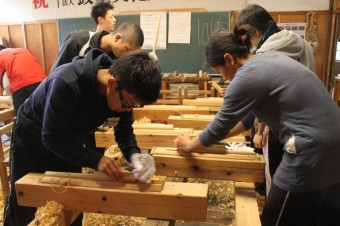
At first, you can’t make them well, but no matter how bumpy or oval your drumsticks are, they are filled with your blood, sweat and tears and you’ll be fond of them. And, it is a really huge shock when one of those drumsticks breaks. We really value them, so much so that we all keep our broken drumsticks for a special send-off, in the form of a lunar new year’s bonfire ritual each January.
Each pair of drumsticks is made from the same piece of wood, and if the sticks aren’t almost the same weight, the tone of the drum beats won’t be the same from your left and right hand. We are particular about our sound, so making drumsticks is very important to us.
In other words, for us, making drumsticks = making sound.
“For Kodo, August Means Earth Celebration” by Tomohiro Mitome
This is Tomohiro Mitome, leader of taiko performing arts ensemble Kodo.
In July, the weather was mostly sunny despite it being the rainy season here. However, there were also heavy rain and flood warnings and landslides ocurred in some areas. Thank you to everyone who expressed their concern for our safety.
As for our tours, the “Kodo One Earth Tour: Mystery” Japan tour members returned to Sado after two and half months on the road and the Kodo “DADAN” Europe tour members left at the beginning of July, gave performances in Spain and France, and have now safely returned to Sado.
Now, it is August.
August means it is time for our annual festival “Earth Celebration” (EC).
This year Earth Celebration will be held for the 27th time. The first evening’s Shiroyama Concert “UMI / OCEAN” will feature the entire Kodo group, from its youngest performers to its veterans. For the second night’s concert “DAICHI / EARTH,” Kodo has invited “BLUE TOKYO.” For the third night’s concert “SHUKUSAI / CELEBRATION,” Kodo has invited two groups: BLUE TOKYO and “DAZZLE,” as well as drummer Tetsuya Kajiwara as a special guest. We will hold concerts for three-days.
The Shiroyama Concerts, EC’s main concert events, take place up on the hill in Shiroyama Park’s lush green surroundings. A star-filled sky and the chirp of cicadas complete this natural outdoor arena. This is one of the only chances you get each year to lie back on the grass and watch Kodo perform outside.
Concerts are not the only focus of Earth Celebration. You can watch the pre-event Noh performance and take workshops to learn taiko, Sado traditional performing arts and dance. You can experience the history, nature and culture of Sado through “Exploring the Charm of Sado Island” activities, watch free Fringe Event performances, and enjoy the international food and goods at Harbour Market. These are just some of the many things that will be on offer at the festival!

This year, EC Theatre is back on the lineup. I will be taking part in this small ensemble performance, called “Kodo Dai Ginjo “Seasoned Quintet.” We have been rehearsing and rehearsing and it will be a special performance, a programme only possible by a small group of us in an intimate venue! We hope you can come along!
So, I hope you will join us for all of EC, not only the main concerts. Please come along for the full three days to thoroughly enjoy all that the festival has to offer.
During the festival, people from all over Japan and all around the world gather in the south-west corner of Sado Island, the Ogi Peninsula where Kodo is based. During the three days of festivities, I hope both repeaters and first-timers alike will enjoy their summer stay on Sado in their own way, at their own pace. We want to have a good time with all of you!
Please come to Sado Island this summer and experience our outdoor concerts for yourself. We are looking forward to seeing you here.
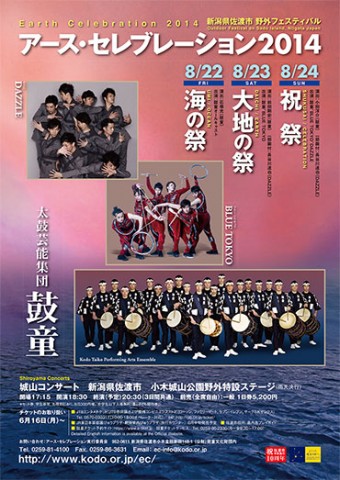
Earth Celebration Shiroyama Concerts 2014
“Kodo and Sado” by Tomohiro Mitome
July 1, 2014
This is Tomohiro Mitome, leader of taiko performing arts ensemble Kodo.
At the beginning of June, the rainy season set in around the Kanto area (near Tokyo) and I expected that it would reach us on Sado by mid-June. However, even though they have had rain on the mainland in Niigata, thanks to some westerlies we have mainly had just clouds and it’s been around 24 degrees on Sado most of the time. It’s is a little chilly in the morning and at night.
This month, I’m going to talk about the connection between Kodo and Sado.
Kodo Apprentice Centre (Kakinoura, Sado Island)
When you include the years of our antecedant group Ondekoza, about 40 years have passed since Kodo established its base on Sado Island. Before merging into one city (Sado City) a decade ago, the island was divided into ten municipalities. At first, our group was based in Hatano Town, then it moved to Mano Town, and finally we relocated to Ogi Town twenty-six years ago. The Kodo Apprentice Centre was located in Aikawa Town for six years, then in Mano Town for four years, and then it moved to its current home of Kakinoura nineteen years ago.
Most of the Kodo members now seen on stage are graduates from our Apprentice Centre in Kakinoura. Looking back, almost 200 young people to date have come to Sado Island to become Kodo apprentices. Some of them stayed on Sado after they finished the apprentice programme, and of course we, the Kodo members and staff, live on Sado, have families, and make our own connections in the community by living here and sending our children to school here.
If you want to know why our group chose Sado Island for its base, well, it’s a long story that requires some time to explain. If you are interested and can read Japanese, please read Kodo’s 30th anniversary publication Inochi Moyashite, Tatakeyo. – 30 Years of Kodo –. You will get to know a great deal about our group and learn about its roots. (Note: This book has Japanese text only with no English translation.)












